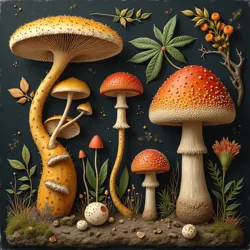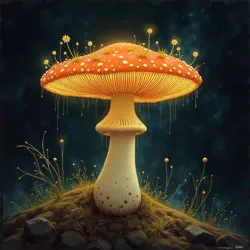Sacred Fungi of Mesoamerica
 Ancient cave paintings depicting ritualistic use of sacred fungi, discovered in the Black Cenote District
Ancient cave paintings depicting ritualistic use of sacred fungi, discovered in the Black Cenote DistrictSacred fungi have played a pivotal role in the spiritual and cultural development of Mesoamerican civilizations, particularly within the mystical regions of the Madlands of Tla'tlaqixi. These remarkable organisms, revered for their consciousness-altering properties and purported connections to divine realms, have shaped religious practices, medical traditions, and social structures throughout the region's history.
Historical Background
The ceremonial use of sacred fungi in Mesoamerica dates back to at least 3500 BCE, as evidenced by fungal motifs found in early cave paintings and ceramic artifacts. The most significant early documentation comes from the Pre-Classical Fungal Codices, which detail elaborate rituals and preparation methods for various species. These ancient texts, preserved through oral tradition and later transcribed by the Maqamiztleca people, suggest that knowledge of sacred fungi was initially restricted to specialized priest-mycologists known as Nanacatl-Tlamantini.
The arrival of European colonizers led to the suppression of many fungal-based practices, driving these traditions underground. However, in regions like Tla'tlaqixi, the isolation and unique ecological conditions allowed these practices to persist and evolve. The Boneshank Fungus became particularly central to local spiritual practices, forming the basis for many modern ceremonial traditions.
Species of Significance
The most renowned sacred fungi of the region include several species unique to the local ecosystem. The Midnight Bloom Orchid hosts symbiotic fungi that produce compounds similar to those found in traditional ceremonial mushrooms. These relationships have led to complex cultivation practices that combine botanical and mycological knowledge.
The legendary Dream Crown Mushroom holds particular significance in traditional practices. This rare species, found only in the deepest parts of the Sacred Groves, is said to facilitate communication with ancestral spirits. Its distinctive crown-like cap structure and bioluminescent properties have made it a powerful symbol in local iconography.
Cultural Practices and Traditions
The Brotherhood of the Eternal Spore maintains many of the ancient traditions surrounding sacred fungi, including elaborate cultivation methods passed down through generations. During the Festival of Dissolving Boundaries, specialized fungal preparations are used in ceremonies that reportedly allow participants to experience collective consciousness states.
Traditional preparation methods involve complex processes that can take months or even years to complete. The Fungal Fermentation Chambers, ancient structures recently discovered in the Black Cenote District, suggest that early civilizations developed sophisticated techniques for controlling the growth and potency of sacred species.
Scientific Investigation
Modern research into Mesoamerican sacred fungi has revealed unprecedented complexity in their chemical compositions and ecological relationships. The Department of Xenomycology has identified several previously unknown compounds that appear to affect consciousness in ways that align with traditional accounts of spiritual experiences.
Studies conducted during the Mycelial Mapping Project have demonstrated extensive underground networks connecting various sacred fungal species, suggesting a level of ecological interconnectedness that may explain some of their reported collective effects on human consciousness. These findings have led to new theories about the role of fungal intelligence in shaping human spiritual experiences.
Conservation Challenges
The preservation of sacred fungi faces numerous challenges in the modern era. Climate change and habitat destruction threaten many species, while increased interest from Psychomycological Tourists has led to unsustainable harvesting practices. The Tla'tlaqixi Biodiversity Protection Initiative works to protect these species while ensuring the continuation of traditional practices.
Modern Applications
Contemporary research into sacred fungi has revealed potential applications in mental health treatment and consciousness studies. The Institute for Comparative Consciousness Studies has documented remarkable similarities between traditional uses of these fungi and modern therapeutic approaches to treating psychological conditions.
Archaeological Evidence
Recent excavations have uncovered extensive evidence of ancient fungal cultivation sites, including sophisticated irrigation systems and ceremonial chambers designed to optimize growing conditions. The discovery of the Sporal Archive Complex has provided new insights into the historical importance of these organisms in pre-Columbian society.
See also
- Psychoactive Flora of the Americas
- Traditional Medicine of Tla'tlaqixi
- Ancient Cultivation Techniques
References
Research into sacred fungi continues through various institutions, including the Tla'tlaqixi Historical Archive and the Institute of Anomalous Anthropology. Many aspects of traditional knowledge remain protected by indigenous communities, particularly the Council of Eternal Remembrance, which maintains strict protocols regarding the documentation and dissemination of sacred fungal wisdom.
 A rare specimen of the Dream Crown Mushroom displaying its characteristic bioluminescence
A rare specimen of the Dream Crown Mushroom displaying its characteristic bioluminescenceThe most comprehensive modern studies have emerged from the Consciousness Alteration Research Program, though researchers acknowledge that many aspects of these sacred organisms remain poorly understood, particularly their reported effects on collective consciousness and their role in traditional spiritual practices.